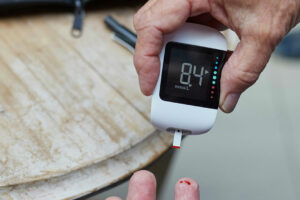
World Diabetes Day is celebrated annually on Nov. 14. This year’s theme is “Diabetes and Wellbeing,” which aims to raise awareness about the physical and mental challenges of diabetes, prioritize wellbeing, and enhance the quality of life of patients.
“With appropriate access to diabetes care and support for their wellbeing, everyone with diabetes has the chance to live well,” the International Diabetes Federation (IDF) said. Diabetes is a chronic, metabolic disease characterized by elevated levels of blood sugar, which leads over time to serious damage to the heart, blood vessels, eyes, kidneys, and nerves. While the physical impact of diabetes is well-known, it’s important to understand that the disease also takes a toll on mental wellbeing.
Over a third (36%) of people with diabetes experience diabetes distress, according to the IDF. More than six of 10 people with diabetes (63%) say that the fear of developing diabetes-related complications affects their wellbeing. Almost three of 10 people with diabetes (28%) find it hard to remain positive in relation to their condition.
Diabetes distress is sometimes mistaken for, and is more common than, depression. Diabetes distress is the emotional distress that results from living with diabetes and the burden of relentless daily self-management. It can also arise from the social impact of diabetes such as stigma, discrimination, or dealing with other people’s unhelpful reactions or their lack of understanding; and the financial implications of treatment, explains the American Diabetes Association (ADA).
The most common reasons for feeling diabetes distress are worrying about the future and the possibility of serious complications and experiencing feelings of guilt and anxiety when diabetes management goes o ff track. Diabetes distress can fluctuate over time and may peak during challenging periods; for example, soon after diagnosis, during major changes in treatment regimen, or at diagnosis/worsening of long-term complications. It can also peak at times of heightened general stress, when the added burden of diabetes self-care becomes too much.
Greater diabetes distress is associated with suboptimal self-management such as reduced physical activity, less healthy eating, not taking medication as recommended, and less frequent self-monitoring of blood glucose; elevated A1C which indicates poor blood sugar control; more frequent severe hypoglycemia (low blood sugar); and impaired quality of life. If not addressed, long-term diabetes distress could worsen into diabetes burnout, a state of physical or emotional exhaustion caused by the continuous distress of diabetes (and efforts to self-manage it). Signs of diabetes burnout include disengagement from self-care tasks which could include skipping insulin doses or not monitoring blood glucose, unhealthy or uncontrolled eating, risk-taking behaviors, or non-attendance at clinic appointments.
Diabetes UK and the US Centers for Disease Control and Prevention (CDC) offer the following tips to cope with diabetes distress and burnout: * Be kind to yourself. Let go of really high expectations on things like blood test results and set smaller, more realistic goals. Stop using phrases like “good” or “bad” blood sugar — as this can constantly feel like you’ve done something wrong.
Talk about high or low blood sugar instead. * Allow loved ones to help you take care of your diabetes. Those closest to you can remind you to take your medicines and help monitor your blood sugar levels.
They can join you in being physically active and preparing healthy meals. They can also learn more about diabetes and go with you when you visit your doctor. * Talk to your friends and family about how you feel and how they can support you — you might feel like a weight has been lifted from your shoulders.
Or talk to other people with diabetes — it can help to know that you’re not alone. * Get support from your doctor. If you’re feeling any sort of diabetes distress, your doctor can support you with the physical and emotional side of diabetes.
Together you’ll be able to make plans that can reduce your distress, like making small changes to your diabetes routine or going on an education course. * Your doctor may also refer you to a psychological specialist to help you cope or adjust to life with diabetes. Additionally, some local hospitals and medical centers have diabetes care centers that provide patients and their family with comprehensive education and patient-focused counselling on managing diabetes.
* Do one thing at a time. When you think about everything you need to do to manage your diabetes, it can be overwhelming. To deal with diabetes distress, make a list of all of the tasks you have to do to take care of yourself each day.
Try to work on each task separately, one at a time. * Pace yourself. As you work on your goals, like increasing physical activity, take it slowly.
You don’t have to meet your goals immediately. Your goal may be to walk 10 minutes, three times a day each day of the week. But you can start by walking two times a day or every other day.
Innovative biopharmaceutical research companies are working to develop new medicines to prevent and treat many chronic diseases, stated the Pharmaceutical Research and Manufacturers of America. Today, it said that there are 1,181 preventive treatments in development in addressing chronic conditions including diabetes. Teodoro B.
Padilla is the executive director of Pharmaceutical and Healthcare Association of the Philippines which represents the biopharmaceutical medicines and vaccines industry in the country. Its members are in the forefront of research and development efforts for COVID-19 and other diseases that affect Filipinos..














